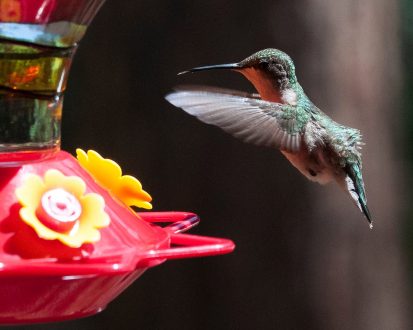Auburn, Alabama — Springtime means the Ruby-throated hummingbirds have migrated back to Alabama from Central America.

Ruby-throated hummingbirds are the eastern species of hummingbirds, which covers the entire state of Alabama. The males have ruby-colored throats and the females have green-tinted throats.
Like all hummingbirds, they are acrobatic and precise in their movements, as any hummingbird observer has seen.
They nest and lay eggs as any bird would, but their nest is smaller and consistent with their body size. Usually, they build their nests on the side of trees with lichens, which are fungi that grow on trees.
“Apple trees tend to be a pretty good place because many apple trees have a lot of lichens on them,” said Dr. Jim Armstrong, an Alabama Extension wildlife specialist and Auburn University forestry and wildlife sciences professor.
The best way to welcome them back is by setting out a hummingbird feeder.
“Hummingbirds are a lot of fun to feed because if you put out a feeder, they will show up,” Dr. Jim Armstrong said. “It does not take them long to find it.”
Local outdoor supply stores sell hummingbird feeders and feed mixtures, but Dr. Armstrong suggests making the feed at home.
“Mix one part table sugar to four parts of warm water,” he said. “Let the water cool before putting in the feeder. Also, there is no need to put red dye in the mixture. The color of the feeder attracts the birds, not the sugar water.”
Flowers further encourage hummingbirds to visit. Tubular, bright flowers like trumpet vines are easy flowers for hummingbirds to get nectar.
Hummingbirds also eat insects, which provides protein. Feeders only provide them with an additional energy course.
“Because of their wingbeat, they burn a tremendous amount of energy,” Dr. Armstrong said. “Sugar is direct energy. That is where that sugar intake comes in.”
The additional energy is imperative before and during their migration to South America in the winter.
“They just have to have a tremendous amount of energy,” Dr. Armstrong said. “There are some that will fly the entire Gulf of Mexico without stopping. That is a long flight for a little bird that has stubby wings. They are not like vultures where they can just glide for miles. They pretty much flap their wings, or they fall. Once they start, they pump away.”
To ensure that hummingbirds will regularly visit a feeder during the warmer months, it is important to keep the feeder clean.
During the summer months, Dr. Armstrong suggests cleaning and refilling the feeder every four to five days depending on the environment the feeder is in and how quickly the hummingbirds feed on the sugar water. He warns of letting the water get cloudy since sugar, water and heat cause fermentation. Putting the feeder in shade can help prevent this.
“I always say it is better to clean them too often than not enough,” he said. “If you have access to a bottle brush, that’s great. Put soapy water in the feeder and shake it up to clean it. Then pour vinegar to help cut the soap film. Let it dry, and start all over again.”
Sugar water attracts ants to the feeders. Buying or making an ant guard helps prevent ants from invading feeders. The guards, like saucers, rest on top of the feeder and should be filled with water.
“It’s a lot of fun to feed hummingbirds,” he said. “It’s a great way to interact with nature because as they use the feeder and become familiar with human activity, they fly near the house and buzz by your head.”
For more information about the Ruby-throated hummingbird, Dr. Armstrong suggests reading Cornell University’s bird guide.
For more information regarding Alabama Extension, please visit www.aces.edu.

